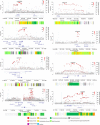Genome-wide association study identifies multiple susceptibility loci for multiple myeloma
- PMID: 27363682
- PMCID: PMC4932178
- DOI: 10.1038/ncomms12050
Genome-wide association study identifies multiple susceptibility loci for multiple myeloma
Abstract
Multiple myeloma (MM) is a plasma cell malignancy with a significant heritable basis. Genome-wide association studies have transformed our understanding of MM predisposition, but individual studies have had limited power to discover risk loci. Here we perform a meta-analysis of these GWAS, add a new GWAS and perform replication analyses resulting in 9,866 cases and 239,188 controls. We confirm all nine known risk loci and discover eight new loci at 6p22.3 (rs34229995, P=1.31 × 10(-8)), 6q21 (rs9372120, P=9.09 × 10(-15)), 7q36.1 (rs7781265, P=9.71 × 10(-9)), 8q24.21 (rs1948915, P=4.20 × 10(-11)), 9p21.3 (rs2811710, P=1.72 × 10(-13)), 10p12.1 (rs2790457, P=1.77 × 10(-8)), 16q23.1 (rs7193541, P=5.00 × 10(-12)) and 20q13.13 (rs6066835, P=1.36 × 10(-13)), which localize in or near to JARID2, ATG5, SMARCD3, CCAT1, CDKN2A, WAC, RFWD3 and PREX1. These findings provide additional support for a polygenic model of MM and insight into the biological basis of tumour development.
Conflict of interest statement
G.T., P.S., G.M., D.F.G., T.R., K.S. and U.T. are employed by deCode Genetics/Amgen Inc. The remaining authors declare no competing financial interests.
Figures


References
-
- Morgan G. J. et al. Inherited genetic susceptibility to multiple myeloma. Leukemia 28, 518–524 (2014). - PubMed
Publication types
MeSH terms
Substances
Grants and funding
LinkOut - more resources
Full Text Sources
Other Literature Sources
Medical
Molecular Biology Databases
Miscellaneous

